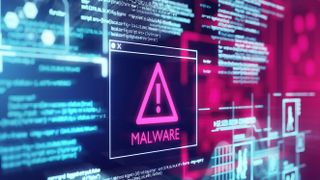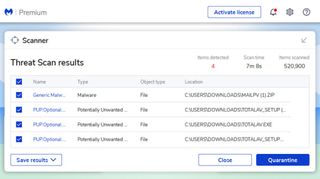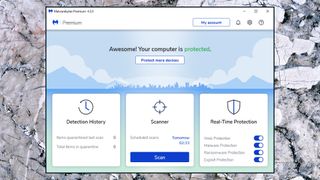How do malware removal tools work?
We shine a light on the inner workings of anti-malware software

Malware removal software is an important part of the armory of tools that can be used to defend your PC from being compromised by a malicious payload of one kind or another.
If you’re wondering how anti-malware tools differ from antivirus, we cover that in-depth elsewhere, but suffice it to say that malware removal apps offer a much more focused kind of protection against malware, and the facilities to rid your system of an infection.
But how do these applications work exactly? Read on for our full examination of how malware removal tools protect your device and what to expect if you install one of these utilities on your system.
<a href="https://www.tkqlhce.com/click-6361382-14452255?sid=hawk-custom-tracking" data-link-merchant="tkqlhce.com"" target="_blank" rel="nofollow">Malwarebytes Premium is today's best anti-malware tool
Save 25% on your security Sometimes free software just isn't enough. Malwarebytes Premium is reasonably priced and uses heuristic analysis to identify new strains of malware, cleans up existing infections, helps protect you from phishing scams, and helps stop you downloading further malicious software.
<a href="https://www.tkqlhce.com/click-6361382-14452255?sid=hawk-custom-tracking" data-link-merchant="tkqlhce.com"" data-link-merchant="tkqlhce.com"" target="_blank" rel="nofollow">Save 25%| $39.99 $29.99
On-demand scanning
As with an antivirus app, when installed on your machine, a piece of anti-malware software will give you the ability to scan the system to check if any malware is present.
There’ll be a ‘Scan’ button on the main menu of the app (most likely, or a submenu perhaps), and simply clicking on that will scan your drive(s) and memory. Just the same as with an antivirus, the malware removal tool will have (regularly updated) definitions of common malware. It’ll look for matches based on the content of this library of definitions, and if anything is found on your PC, that will (obviously) be flagged as malicious.
That will happen in a post-scan report, where any suspect discoveries are highlighted, and you’ll get the option to quarantine these offenders (or indeed malware might be automatically quarantined). Quarantining, as you might expect, is the banishment of a file to a cordoned-off area of the system, where it can no longer reach or harm your device or data.

As well as malware, Potentially Unwanted Programs (known as PUPs for short) may be reported in scan results, which are, as the name suggests, apps that you might not want on your system (a good anti-malware app will explain why they’re possibly undesirable). These don’t have to be quarantined, as they’re not actively doing any harm, so it’s up to you whether to take action on those. (You’re better safe than sorry in these cases, more than likely, but occasionally legitimate apps can be flagged, and you may want to ignore warnings in these cases).
Are you a pro? Subscribe to our newsletter
Sign up to the TechRadar Pro newsletter to get all the top news, opinion, features and guidance your business needs to succeed!
This on-demand scanning is present with all anti-malware software, and one approach that some folks take is to install a freebie malware removal app just to sit on their system as a backup to a primary antivirus.
In other words, the tactic here is to rely on the antivirus in the main, but to run a manual scan with a second line of defense – the anti-malware – every now and then, just to see if it picks up on anything that the antivirus could have missed. That might only be a PUP, and not outright malware, but still, it could be something that you don’t want on your system, and would otherwise have sat there if you hadn’t plumped for a second opinion.
Real-time defenses
Malware removal software can give you more than just on-demand scanning, though, and some apps offer real-time defenses in the same vein as an antivirus. Real-time protection simply means that the anti-malware tool has a constant shield up, scrutinizing every file being introduced onto your system (and the processes currently running) for anything suspicious.
That gives you more watertight protection, and means you can run an anti-malware app as your frontline protection against malware, with no need for an antivirus (at least in theory).
Obviously it helps if you choose one of the best tools of this purpose, such as our current top-ranked pick Malwarebytes. Its premium version sports real-time protection, backed up by heuristics (monitoring for malware-like behavior, to catch threats which are brand new and not yet included in the program’s library of malware definitions).

Remember that anti-malware is built to major in such behavioral detection, and finding fresh threats that an antivirus might miss. You also get web defenses (against phishing and other online scams) for safer browsing, plus anti-ransomware tech – a broader level of protection, in other words, from the paid Malwarebytes app (as you might expect).
All that said, it’s still true that the best antivirus apps may offer a more accurate malware detection engine – at the time of writing, that is indeed the case according to the independent test labs, although Malwarebytes is rated solidly enough for overall protection – so you may prefer to run one of our best antivirus picks backed up by the free version of Malwarebytes (or your preferred anti-malware choice) for on-demand duties.
How do malware removal tools work?
Whatever the case, anti-malware apps offer a laser-focused protection against malware (and the likes of PUPs), and as we’ve seen, the good ones can work on multiple levels just like antivirus – with on-demand, plus real-time protection backed with heuristic tech – running the gamut of defensive countermeasures against all the nastiness out there, including ransomware, phishing and more.
- Get backed up safely with secure cloud storage solutions
- The big question...Is free antivirus safe?
- How to clean up your Windows PC with an anti-malware tool
Darren is a freelancer writing news and features for TechRadar (and occasionally T3) across a broad range of computing topics including CPUs, GPUs, various other hardware, VPNs, antivirus and more. He has written about tech for the best part of three decades, and writes books in his spare time (his debut novel - 'I Know What You Did Last Supper' - was published by Hachette UK in 2013).

